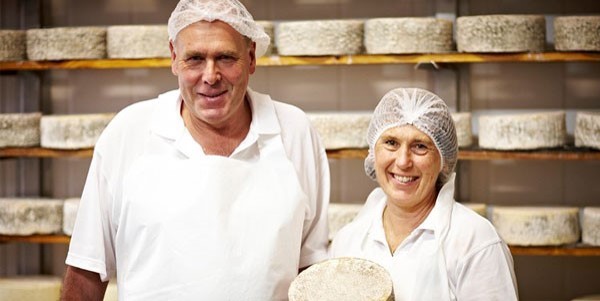A Taste of Authenticity: Floridia Cheese Melbourne and Its Workmanship
Opening the Secrets of Artisanal Cheese Making: A Step-by-Step DIY Overview
In the realm of culinary workmanship, artisanal cheese making stands as a testimony to the delicate equilibrium between practice and development. Each action in the process, from selecting the ideal milk to refining aging techniques, holds within it a wealth of expertise passed down through generations. As we start this journey to debunk the art of developing charming cheeses, we are confronted with a tapestry of secrets and skills waiting to be deciphered. Join us as we discover the ins and outs of this old craft, where patience, scientific research, and art assemble to create tastes that entice the detects.
Picking the Right Milk
When getting started on the trip of artisanal cheese production, the option of milk plays an essential function in establishing the quality and features of the final product. The kind of milk selected influences the flavor, structure, and on the whole account of the cheese.
When selecting milk for cheese making, it is essential to think about the fat web content. Higher fat content in milk can lead to a creamier and richer cheese, while lower fat content might result in a drier and firmer texture. Furthermore, the source of the milk, whether from cows, goats, sheep, or buffalo, contributes unique flavors and features to the cheese (Floridia Cheese). Each kind of milk brings its own nuances, permitting a wide variety of cheese ranges to be crafted based upon the selected milk. Eventually, the choice of milk is a basic decision that sets the foundation for an effective artisanal cheese-making undertaking.
Culturing and Coagulating
To initiate the cheese-making process, the vital actions of culturing and coagulating need to be very carefully executed to transform milk right into curds and whey. Culturing involves introducing helpful germs to the milk, which after that begins the fermentation process. These microorganisms convert lactose (milk sugar) into lactic acid, developing the acidic atmosphere needed for coagulation. The sort of society used can considerably affect the taste, appearance, and ripening of the final cheese item.

The timing and temperature level control during culturing and coagulation are essential aspects that influence the final outcome of the cheese. Proper implementation of these steps is vital to ensure the preferred appearance, taste, and uniformity of the artisanal cheese being produced.
Draining and Pressing Curds
After the milk proteins have actually coagulated and the curds have been cut to launch whey, the following crucial action in artisanal cheese making involves draining pipes and pressing the curds to accomplish the preferred appearance and consistency of the last cheese product. Draining is the procedure of separating the curds from the go right here whey. This can be done by transferring the curds into a cheesecloth-lined colander or mold and allowing the whey to drain pipes off normally. The moment for draining pipes can differ relying on the sort of cheese being made and the wanted dampness material.
Pressing assists expel any type of remaining whey and compacts the curds to develop a strong cheese wheel. Appropriate pushing and draining pipes are crucial steps that significantly affect the high quality and attributes of the artisanal cheese being created.
Aging and Flavoring Techniques
Implementing meticulous aging and flavor methods is pivotal in enhancing the depth and complexity of artisanal cheeses, elevating their preference accounts to exquisite degrees of improvement and sophistication. Aging plays a vital role in developing the one-of-a-kind tastes and textures that distinguish artisanal cheeses. Throughout the aging procedure, cheeses are stored in thoroughly controlled environments where aspects such as temperature level, humidity, and airflow are manipulated to urge the development of beneficial molds and bacteria. This controlled atmosphere enables the cheese to develop gradually, developing intricate fragrances and rich tastes.
Flavoring strategies likewise contribute significantly to the final preference of artisanal cheeses. Cheesemakers might pick to introduce extra flavors by incorporating components such as natural herbs, flavors, or perhaps fruits right into the cheese throughout the production process. Additionally, some cheeses are cleaned or scrubed with various liquids, such as salt water or alcohol, to enhance their textures and flavors.
Covering and Storing Cheeses

Verdict
To conclude, understanding the art of artisanal cheese making involves thoroughly choosing the best milk, adhering to accurate culturing and coagulating procedures, draining pipes and pushing curds successfully, and using numerous aging and flavor strategies. By following these actions carefully and with attention to detail, you can produce your own delicious and one-of-a-kind cheeses in the house. Bear in mind to cover and keep your cheeses appropriately to make look at here now certain optimum taste and texture growth. Satisfied cheese making!
Each kind of milk brings its own nuances, permitting for a broad variety of cheese ranges to be crafted based on the chosen milk.After the milk proteins have coagulated and the curds have actually been cut to release whey, the next important action in artisanal cheese making involves draining and pushing the curds to achieve the wanted structure and uniformity of the final cheese product. Many cheeses ought to be covered in wax paper or cheese paper to allow them to take a breath while securing them from drying out. For cheeses that need to proceed aging, such as bloomy peels or washed skins, ensure they are kept in a trendy atmosphere like a cheese cavern or a fridge set to the proper temperature level. By paying interest to the wrapping and storage of artisanal cheeses, cheese makers and fanatics can maintain the stability of these specials and totally appreciate their intricate tastes.